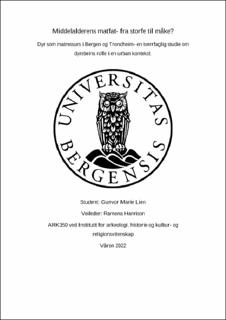Middelalderens matfat- fra storfe til måke? Dyr som matressurs i Bergen og Trondheim- en tverrfaglig studie om dyrebeins rolle i en urban kontekst.
Master thesis
Permanent lenke
https://hdl.handle.net/11250/3000147Utgivelsesdato
2022-06-03Metadata
Vis full innførselSamlinger
- Master theses [243]
Sammendrag
Food and consumption in the Middle Ages is a well discussed topic, but a lot of the zooarchaeological material from urban medieval centres in Norway have been left alone since their initial analysis. In this thesis I seek to bring such information back into the light of day, as well as compare the old zooarchaeological material to the newly discovered. Written medieval sources, finds related to cooking and plant material from the sites can alongside animal bones from Trondheim and Bergen from the 11th to the 16th century tell us more about which animals medieval people ate and included in their system of consumption. The sites in question are Folkebibliotekstomten in Trondheim, and Dreggen, Rosenkrantzgaten 4, Kong Oscars gate and Øvre Korskirkeallmenning in Bergen. The material will be presented in new ways to make the information more accessible, and hopefully easier to work with in future projects. Value theory, consumption theory and structuration theory will be used to interpret the bones and the animals role in the medieval foodway. The different methods used will also be discussed, mostly because of the divide between older and newer excavations. Additionally, changes and tendencies in the material over time will be assessed. Throughout the project it soon became clear how theories about medieval food have been too fixated on the consumption of mammals at the expense of marine resources. Fish, both fresh and dry, seem to have been more important than previously thought after interpreting the newly discovered material together with the written sources. Furthermore, the bird remains show a different story with a shift from wild species to a higher number of domesticated birds as times goes on. Finally, it is considered whether such material must be seen in relation to a hierarchical system, or if the material itself can be used to inform on the social system, especially when interpreted together with the other archaeological finds.
